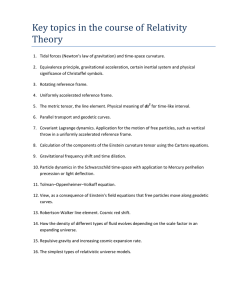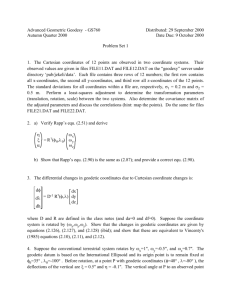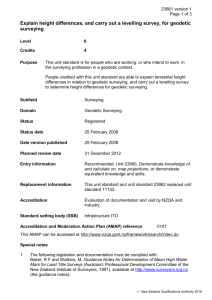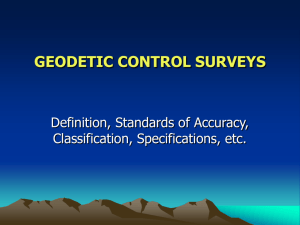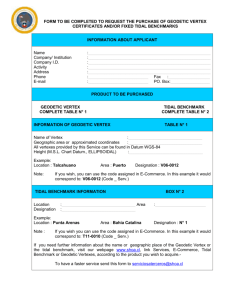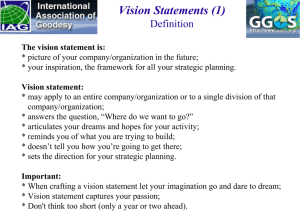14th Congress of the International ... Hamburg 1980 Commission III Presented Paper
advertisement
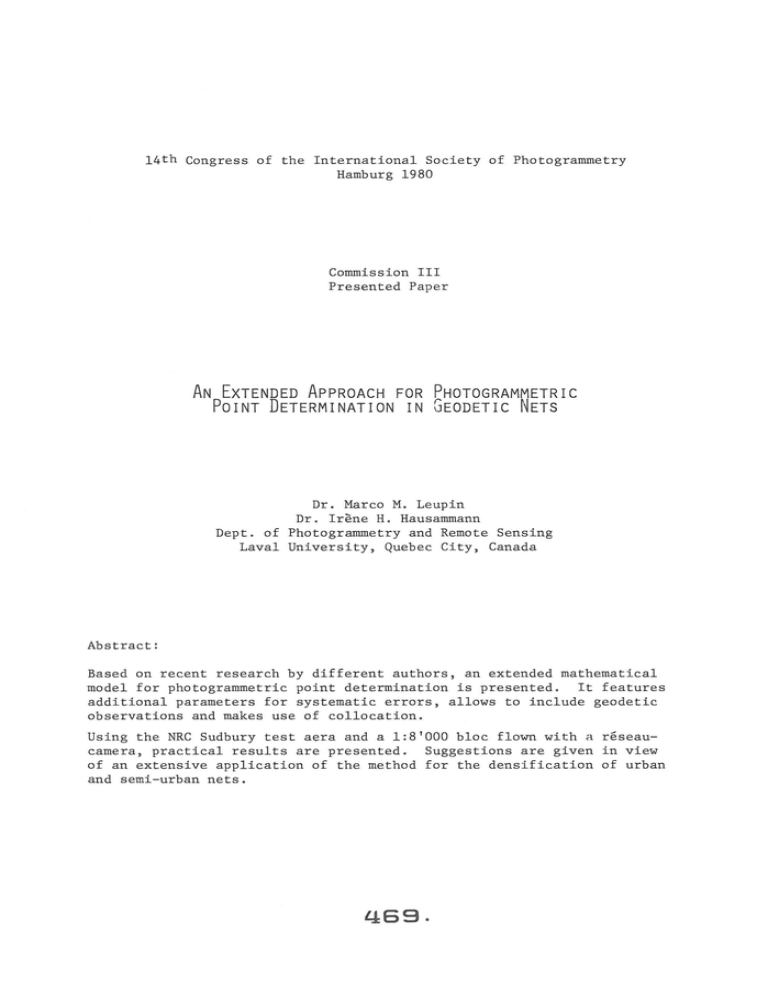
14th Congress of the International Society of Photogrammetry Hamburg 1980 Commission III Presented Paper AN EXTENDED APPROACH FOR PHOTOGRAMMETRIC PoiNT DETERMINATION IN GEODETIC NETS Dr. Marco M. Leupin Dr . Irene H . Hausarnrnann Dept . of Photograrnrnetry and Remote Sensing Laval University, Quebec City, Canada Abstract: Based on recent research by different authors, an extended mathematical model for photogrammetric point determination is presented . It features additional parameters for systematic errors, allows to include geodetic observations and makes use of collocation. Using the NRC Sudbury test aera and a 1 : 8'000 bloc flown with a reseaucamera, practical results are presented . Suggestions are given in view of an extensive application of the method for the densification of urban and semi-urban nets. An Extended Approach for Photogrammetric Point Determination in Geodetic Nets 1. Introduction For the last pas years , photogrammetry has successfully been used to densify geodetic nets , especially in cadastral applications (Gruen /3/) . The Ministery of Energy and Ressources of the Province of Quebec (who is responsible for the 2na and 3rd order net) has shown particular interest in the matter . A cadastral map revision is due and in view of the major cost involved, several options are carefully looked at . A densification of the net would be considered in two different zones: 1 . Urban areas with existing 3rd order net . a point every 200 m. Densification with roughly 2 . Semi-rural areas with existing 2nd order net . point every 500 m to 1000 m. Densification with a A first practical experience (Leupin and Grenier /4/) helped to evaluate several problems mainly associated with a somewhat doubtful quality of the control points and poor tie points between the strips . The present paper tries to extend the mathematical model of an aerial triangulation in order to balance out the influence of inconsistent geodetic control points . 2. Additional geodetic observations and constraints Whatever the size and the form of the photogrammetric bloc , it is always difficult to assure the needed dense control point distribution on the bloc rim with already existing trigonometric points . Therefore , the usual way consists of measuring additional control points to fill out the gaps . Relating these points to their geodetic datum is sometimes a formidable task in inaccessible terrain. More flexibility can be gained if one allows to partially replace control points by other geodetic observations , above all distances . This idea has been realized for the first time by Elphingstone and Wong in their SAPGO program . At the same time , constraints should also be included . A practical example is the "lake constraint" in the SPACE-M program , an extremly useful tool in bloc-height stabilisation in regions where lakes abund. 3 . The mathematical model This additional flexibility by using geodetic observations presumes an extension of the mathematical model, allowing a simoultaneous adjustment of geodetic and photogrammetric observations . Theoretically, the gain in accuracy with this rigorous approach is minimal and doesn't justify the numerical problems related to it . On the practical side however, the gained geodetic flexibility can make quite a difference in the overall cost . El Hakim /2/, picking up the SAPGO conception , has derived the formulas in a three-dimensional carthesic coordinate system . Using the same notation we get for the photogrammetric model Fp 1 (X ~ 2 X ~ Lp) = 0 £:1:70. (1) with x1 orientation elements, calibration parameters, geodetic coordinates , Lp image coordinates . x2 Linearizing (1) Wp -t- Ap 1X1 Ap 2 X2 + BpVp -t- (2) = 0 discrepancies rtp image coordinate residuals Vp Ap _, Bp design matrices . Ap1_, 2 in which In the same way as in (1) we can write the geodetic model with the index g as (3) x3 orientation unknown, refraction unknown, astron. coordinates geodetic observations Lg and linearizing (3) Wg + Ag 1 X2 + Ag 2 X3 + BgVg = 0 . (4) In addition to El Hakim, a "constraint" model is proposed, which , once linearized, can be written as (with the index c) We + Ae 1 X 1 + Ae 2 X 2 + Ae 3X 3 (5) = 0. The function to be minimized can now be established with ~ T ~ ~ T ~ = Vp PpVp -t- Vg PgVg + ~Px 1 j\ ~ t T iiPx 2 X2 + X31 .~ 3 X3 ~ ~ -t- 2kp (Wp + Ap 1X 1 + Ap 2 X 2 + BpVp) 2kgT (Wg + Ag 1i 2 + Ag 2 X3 + BgVg) -t- 2ke (We + Ae 1 X 1 + Ae 2 X 2 + Ae 3 X) . -t- (6) The result can be expressed as hyper-matrix Pp 0 0 0 0 0 0 vp 0 0 Pg B~ 0 0 0 0 Vg 0 Bg 0 0 0 Ap 1 Ap 2 0 0 kp Wp 0 Bg 0 0 0 0 0 T Ap 2 ApT 0 0 0 0 AgT 1 T Ag 2 0 0 0 0 0 0 2 Ag 1 Ag 2 Px 1 0 0 0 px 2 0 0 0 Ae 1 Ae 2 0 -t- X T Ae 1 AeT = 0 0 0 2 T Px 3 Ae 3 Ae 3 0 Wg X3 0 k.e We X X After the elimination of Vp, Vg, kp and ke the vectors 3 , 2 , and X~ can be computed . The detailed derivation can be found in Monvoisin /5/ . However , it has to be stated clearly that the inclusion of the geodetic and "constraint" model destroys partially the band structure of the normal equations. Recently , similar band structures have appeared in geodesy as well and suitable algorithms have been derived . These is no reason why these methods could not be applied to this particular case . 47:1. 4. The use of collocation Based on El Hakims conclusions, which recommend the use of collocation as long as reseau-images are available, the mathematical model has been extended to incl ud e collocation in geodetic observations. With the equations (2) and (3) ~ Wp + AplXl + Ap2X2 + B*Vp Wg + AglX2 + Ag2X3 + B*Vg ~ =0 =0 We define the residual vectors ( with sp sp Vp B* - ·l\ Vg = and - sp) - sp + Vp ( ~ :~) + Vg (sg) the signal of the computed photograrnrnetric (geodetic) points, (sg) the signal of the observed photogrammetric (geodetic) points, (Vg) the residuals of the photogrammetric (geodetic) observations, = (0; -1; -1) . The inverse weight matrix of the photograrnrnetric (and with the index g for the geodetic) observations becomes Pp-l = L.sp ( ~spsp L.spsp L.sp 0 L) with the known solution X= -[AT (L.s + L.L)- 1 A + PxJ- 1 AT (L.s + L.L)- 1 W. Various tests have shown that it is imperative to establish appropriate a-priori variance-covariance matrices if one wants to apply collocation successfully. The most efficient way to achieve this in photograrnrnetry is by using rcseau-cameras . Unfortunately, the effort spent in measuring all reseau-crosses i s far from being negligable and it can not be justified in a production environment. A good compromise is to measure around 50 reseau points in two successive images per strip and then interpo late the results for the other images . First practical result s have shown that this approach works far better than trying to set up empirical variance-covariance matrices without measuring reseau-crosses . The presented mathematical model gives a maximum of flexibility : it includes geodetic observations and constraints, accepts additional parameters and adjusts according to the general form of collocation . Nevertheless , a price has to be paid on the numerical side . This is the main reason why up to now only small blocs can be computed . 5. Pre-analysis of the geodetic net As flexible as the mathematical model of aerial triangulation may be, it can not improve poor geodetic observations . This opens the doors to a somewhat different strategy , yielding to an a-priori analysis of the geodetic points used as control points in the aerotriangulation . 472. The analysis whould be done before undertaking the flight. If needed, additional measurement..-; can be performed to improve the quality of the control points. Several methods have been presented in the last years, one of the most suitable for this purpose being the go called "Main - Eigenvector Procedure" proposed by Pelzer in Hannover /1/. The basic idea is to obtain moore information than offered by the error ellipses of the points. The method exploits the whole variance-covariance matrix instead of using the diagonal elements only for the error ellipses. The method carries out a spectral analysis of the variance matrix Qxx = SDST D is a diagonal matrix, containing the eigenvalues Ai of Qx~· S is an orthogonal matrix, whose columns Sj represent the eigenvectors associated with the A.i. Spectral analysis shows that the largest eigenvalues produces the largest contribution. The "Eigenvector-Criterion" looks after a geometric interpretation of the eigenvector associated with the largest eigenvalue. s QXlXl Qxlyl Qxly2· • • QYlXl = I•• Xl 1 s Yl sX2 I A. 5 x1 •. syl ••• l I I lk ?k I I 8 I Associated eigenvector I l Largest eigenvalue There is no reason why otller methods should not be included, in fact, every information on the quality of the control points must be welcomed. But one has not to forget the fact that we are dealing with more or less completed geodetic nets which can only be completed by some additional observations . The allowed margin is limited and there is no place for optimizing criteria. 6 . Practical results Even it the research is still under way, first experiences have been gained showing the potential of the approach. The Thetford-Mines area /4/ was used for a pre-analysis of the control points . 55 geodetic points are available in this area, with some points showing a lower accuracy than others. Despite the fact that all error ellipses have been computed, no particular weakness of the net could be found. Yet with the help of the spectral analysis two zones needing some kind of reinforcement could be detected . Several additional distances q73. helped overcome this situation . Presently , the research has been extended to a more reliable test field, the NRC Sudbury test area . With close to 400 practically error free control points and blocs flown at different scales with reseau-cameras, this area is ideally suited for investigations of this kind . The 1 : 8000 bloc (24 models in 3 strips) has been chosen as basic bloc, backed up by the 1 : 6000 bloc (35 models in 3 strips) . In addition of measuring every point on the NRC ANAPLOT , 49 reseau crosses have been observed in 3 images per strip . Observed distances can easily be simulated and first results simulating the existing control point density in practical applications are very encouraging . The highlights can be summarized as follows : 1 . A pre-analysis of the geodetic points used as control is a worthwile effort . It allows to establish the kind of necessar additional geodetic observations . 2 . The possibility of using distances is an extremly powerful tool and brings a considerable simplification of the field work . 3 . The inclusion of the "constraint-model" can have its advantages in planimetry, especially in large scale applications in populated areas, where artificial features abund . In altimetry, it improves the height stabilisation of the bloc . 4 . Fragmentary reseau- observations (2 or 3 images every strip) combined with collocation techniques refine the mathematical model and should be applied wherever accuracy is of prime importance. 7 . Conclusions If there are any doubts as far as the quality of the geodetic points used as reference in an aerial triangulation is concerned, a refined mathematical model should be applied . It allows the inclusion of additional geodetic observations, additional parameters and collocation . In many cases, a pre-analysis of the net should be undertaken before the aerotriangulation adjustment . Numerical and practical problems have still to be solved to bring the method within reach of practical application . The gained experience shows that these efforts are justified in photogrammetric point densification, where the highest possible accuracy has to be obtained . Acknowledgements : Mr . P . Monvoisin, M. Sc . has been involved in the theoretical part of this paper . The authors would also thank Mr . R . Moreau of the Ministery of Energy and Ressources of Quebec for his interest and Mr . Z . Jaksic, Head of the Photogrammetric Research Branch at NRC, for making the Sudbury test material available and helping out with software . References /1/ DUPRAZ , H. and W. NIEMEIER : Un critere pour l ' analyse des reseaux geodesiques de controle . Vermessung, Photogrammetrie , Kulturwesen 4/1979 , 70-76 . /2/ EL-HAKIM , S . F . A.: Potentials and limitations of photogrammetry for urban surveying . Ph . D. thesis , Dept . of Surveying Eng . U. N. B., 1979 . II /3/ GRUN , A.: Zur Anwendung der modernen PrMzisionsphotogrammetrie in der Netzverdichtung und Katastervermessung . ZfV 104 (1979) , S . 85-97 . /4/ LEUPIN, M. and P . GRENIER : Densification Photogrammetrique , Rapport de Recherche, G43 , 1978, Ministere des Terres et Forets , Quebec . /5/ MONVOISIN , P .: Contribution au prob l eme des erreurs systematiques geodesiques en aerotriangulation . These de Maitrise , Dep . de Photogrammetrie , Universite Laval , 1979 .

